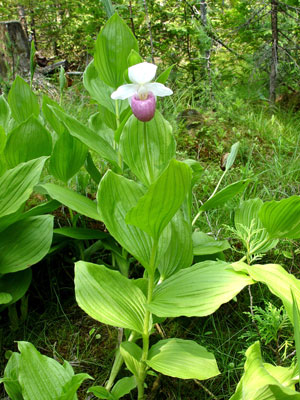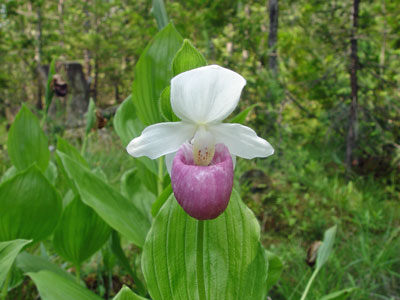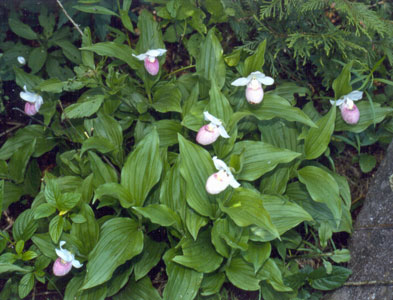DACF Home → Bureaus & Programs → Maine Natural Areas Program → Communities, Plants, and Animals → Rare Plants → Cypripedium reginae

Cypripedium reginae Walt.
Showy Lady's-slipper
- State Rank: S3
- Global Rank: G4G5
- State Status: Special Concern
Habitat: Circumneutral peatlands (often at edges) or sunlit openings of mossy woods. [Forested wetland; Open wetland, not coastal nor rivershore (non-forested, wetland)]
Range: Newfoundland to North Dakota and Manitoba, south in Appalachians to Georgia.
Aids to Identification: The largest and showiest of our lady's-slippers. Foliage of non-flowering plants emerging in early spring may be mistaken for false hellebore. Flowering plants are unique with their tall leafy stems bearing one or two large flowers with white petals and sepals contrasting with magenta pink pouch. Densely pubescent throughout, the hairs may cause a rash similar to poison ivy.

Ecological characteristics: Showy lady's-slippers apparently require constant moisture, some sunlight and circumneutral soil conditions. In acid bogs their roots go under the acid Sphagnum to more neutral groundwater below. In clearings or woods edges colonies may be very large and flowering abundant, but plants in deep shade often lack flowers. C. reginae seeds seem to germinate best at depths of at least 5 cm. It has been suggested that this may account for the presence of dense colonies in deer yards where the deer hooves may help to push seeds to the appropriate depth. C. reginae takes about 15 years to reach flowering age, which explains why they are slow to reappear after colonies have been dug up.

Phenology: In Maine flowers late June to July.
Family: Orchidaceae
Synonyms: Cypripedium spectabile Salisb.
Known Distribution in Maine: This rare plant has been documented from a total of 62 town(s) in the following county(ies): Androscoggin, Aroostook, Cumberland, Hancock, Kennebec, Knox, Oxford, Penobscot, Piscataquis, Somerset, Washington.
Reason(s) for rarity: Habitat destruction and collecting, also scarcity of suitable habitat.
Conservation considerations: Orchids are popular among some speciality gardeners, and populations of this species are vulnerable to unscrupulous or uneducated collectors. Plants dug from the wild usually do not survive; more importantly, removing these plants harms the natural population and may cause its eventual disappearance. Tissue-culture propagation of this species has been tried in limited instances, but any plants offered for sale have almost certainly been dug from the wild. This orchid grows and flowers best in moderate sunlight, and partial removal of the canopy can benefit the populations, if done correctly.